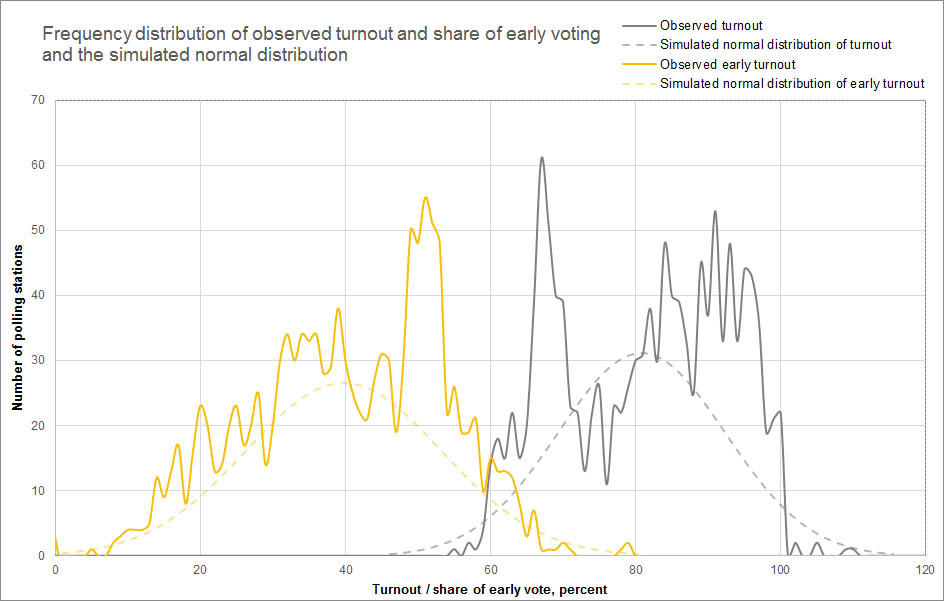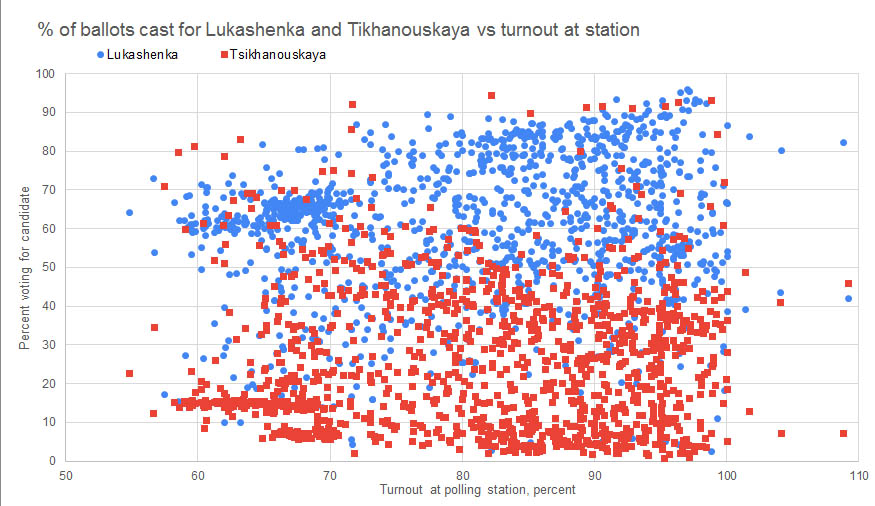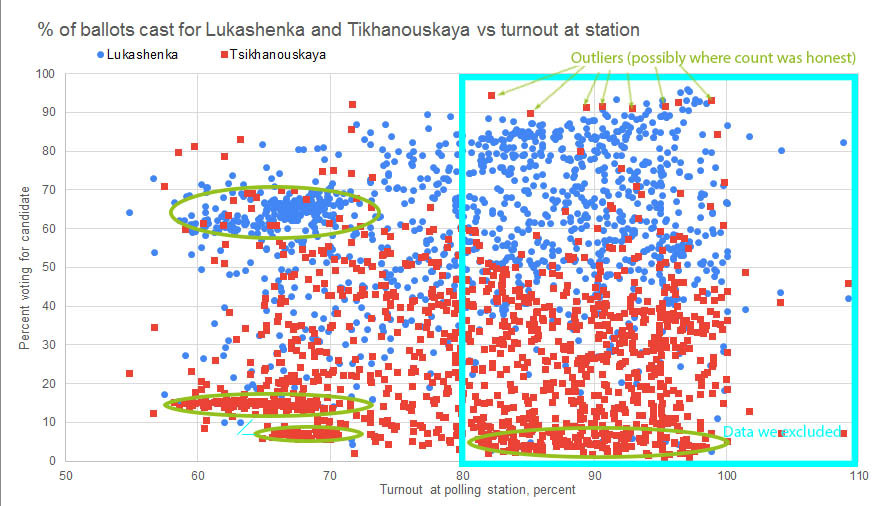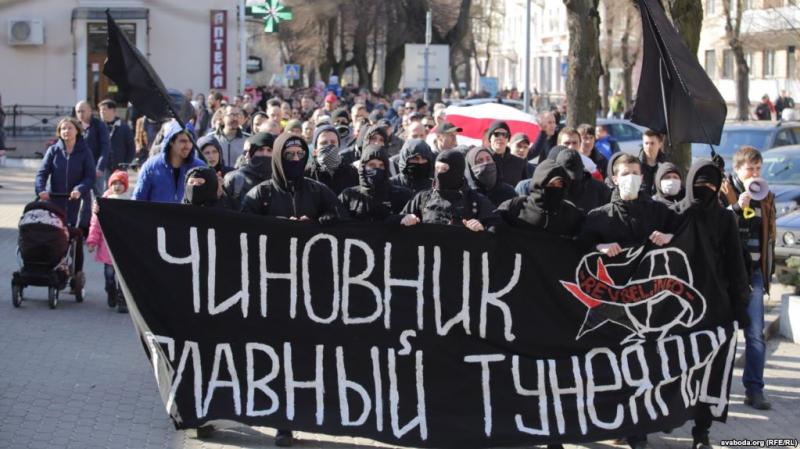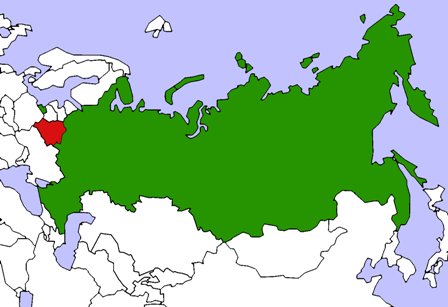Given that, to the best of our knowledge, Sviatlana Tsikhanouskaya would have won the election if it wasn’t rigged, Euromaidan Press will be referring to Alyaksandr Lukashenka as the self-proclaimed president-elect of Belarus, following in the footsteps of Russia’s Novaya Gazeta and Ukraine’s Ukrainska Pravda outlets.
More and more countries are declaring the 9 August 2020 elections in Belarus invalid, the latest of them being Lithuania and the United Kingdom; as well, the EU rejected their results in a meeting on 19 August.
After several days of vicious police brutality against peaceful protesters protesting a rigged vote, the Central Elections Committee of Belarus (CEC) declared that Lukashenka won with 80.1%, while his challenger Sviatlana Tikhanouskaya had scored a mere 10.1%. The unprecedented protests keep growing, with more and more social classes publicly stating they don’t believe the results of the vote landing Lukashenka his sixth term in office.
The overwhelming popular support for Tsikhanovskaya is reflected in the rallies rocking Belarus for more than a week. Last Sunday, the marches in support of her were estimated to gather 500 000 nationwide, while a rally in support of Lukashenka in Minsk, to which state employees were bussed from the regions, gathered only 13 000-31 000, by different estimates.
So, what evidence do we have that Lukashenka falsified the vote? And how did he manage to pull it off?
1. Neither free nor fair
Before examining the statistical evidence for a rigged vote, we must first address how the election was rigged in favor of Lukashenka before voting day.
The Dead Lawyer’s Society, a Ukrainian Bar association, made a helpful overview of violations while calling upon the Ukrainian authorities to do more to support the Belarusian people.
[highlight]1. Candidates barred from participating.[/highlight] Two of Lukashenka’s contenders, Sergei Tsikhanouskiy and Viktar Babaryka, as well as their campaign coordinators, were jailed; Babaryka and the third one, Valeriy Tsapkala, were denied registration. Tsapkala and his wife Veranika were threatened with criminal proceedings (at publication date, both had left Belarus).
Tsikhanouskiy and Babaryka remain under custody despite multiple requests to change precautionary measures to more lenient ones – some of Babryka’s supporters were given 15 days of jail for “conducting unauthorized rallies” when they came to submit their requests to bail him out. Babaryka’s lawyers were barred from visiting him in prison.
During the verification of signatures required for candidates’ participation in elections, hundreds of thousands of signatures were rejected; appeals against this decision were declined by both the CEC and court.
Many of the signatures in support of Babaryka and Tsapkala were determined invalid due to letters from the police, allegedly due to inaccurate information about the name. Others were rejected after an “expert assessment,” during which dozens of thousands of signatures were verified, rather implausibly, over a mere three days.
[highlight]2. Citizens barred from participating.[/highlight] During the entire campaign, campaigners were arbitrarily detained; usually, this was done by civilian-clad police, habitually – without explaining the reasons for the detention or for opening an administrative case but using physical force. Often, such incidents were used as reasons for politically active citizens being fired or denied work incentives; students could be disenrolled. [highlight]3. Election commissions were not independent.[/highlight] From the 2800 persons who gathered the right to work as members of territorial election commissions through a public flashmob by gathering ten required signatures, only 6 (six) were admitted. Highly qualified observers from the initiative “Honest people” were not chosen.The Dead Lawyers Society claims it has audio recordings testifying to a conspiracy due to which citizens attempting to be admitted to election commissions were rejected.
Thanks to this, the commission members mostly consisted of workers of state enterprises and state officials who had participated in rigged elections before, which is a “statistically impossible picture,” says the Dead Lawyers Society:
“out of all the variety of candidates, at all the polling stations, commissions were invariably formed out of members of one labor collective, mostly those who already had experience of participating in election campaigns… to ensure that further falsification of voting is possible.”
Additionally, according to the Belarusian human rights center Viasna, only 0.009% of the members of election commissions at polling stations represented opposition parties, as 98.9% of applicants were rejected. Most of the election commissions were represented by members of the five major Belarusian GONGOs.
[highlight]4. Independent observers were rendered meaningless.[/highlight] Before 24 July, they were not accredited under the pretext of the necessary registration book not yet being available; after 24 July, it turned out that, miraculously, 5-15 observers were already registered for this polling station.Under the pretext of fighting COVID-19, despite Belarus not having officially introduced any coronavirus-related restrictions, observers were limited from observing the voting process. A schedule was created for accredited observers, who were allowed to be present on the territory of the polling station one at a time. At other times, they were relocated outside the building of the station, and on some occasions, outside the territory altogether – like outside the fence of a school, which rendered observation meaningless.
Further contributing to abrogating the institute of observers, they were detained without reason and the violations they registered, like Russian citizens voting, were not addressed. Finally, independent observers were not admitted to observe ballot counting, while observers from pro-government structures were.
According to the Viasna human rights center, independent observers took the main blow of the Belarusian regime these elections.
[highlight]5. The abused early vote.[/highlight] According to officials, a record 42% of voters had cast their votes in the five days before election day. This early vote became the Lukashenka regime’s main vehicle of falsification.In many incidents where observers were present outside the stations, the total turnout exceeded 100%, Some polling stations had event declared a turnout that was inflated tenfold. Before the main voting started on 9 August, independent observers registered that the lists of persons who voted were nearly empty on nearly all stations – meaning that no real people had voted.
According to Viasna, a coordinator of the “Human rights defenders for free elections” initiative, only 11.6% of accredited observers were allowed to actually observe the situation at the polling stations at least some time of the early voting; only 1 of 798 from the initiative could observe them all 5 days of the early voting.
But even in that short period, Viasna observers saw many incidents of forced organized voting of such categories of the population as military men, police, state employees, dormitory residents, and of inflation of the turnout.
On election day, observers could not observe voting inside the polling stations or polling at home; they did not have access to lists of voters registered at polling stations, leaving ample space for manipulations.
Noteworthy is the analysis conducted by the Dead Lawyers Society comparing the voting at 11 foreign polling stations and 997 ones in Belarus. At the foreign ones, it is Tsikhanouskaya winning by a landslide, not Lukashenka:
| Belarusian polling stations: 997 processed | ||||||
| All voters | Dmitriev | Kanapatskaya | Lukashenka | Tikhanouskaya | Cherechen | Against all |
| 1431870 | 24583 | 31589 | 893542 | 395940 | 44057 | 39404 |
| 1,72% | 2,21% | 62,40% | 27,65% | 3,08% | 2,75% | |
| Foreign polling stations: 11 processed | ||||||
| All voters | Dmitriev | Kanapatskaya | Lukashenka | Tikhanouskaya | Cherechen | Against all |
| 3149 | 18 | 23 | 397 | 2651 | 8 | 14 |
| 0,57% | 0,73% | 12,61% | 84,19% | 0,25% | 0,44% | |
2. The parallel vote count
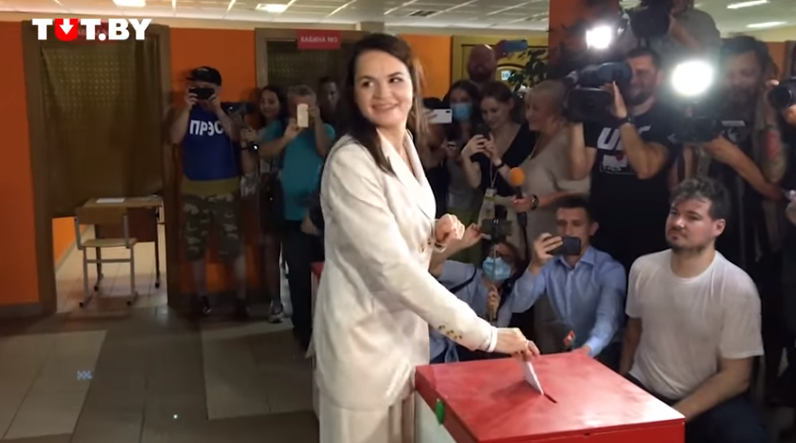
These elections, Belarusians fought for their right to an honest vote. Multiple initiatives sprung up to resist falsifications.
Another one was Zubr, where users uploaded photos of protocols from polling stations and observer groups recorded violations.
A comparison of the data from both platforms revealed that Lukashenka’s 80.1% result is impossible, a report by Golos says.
[highlight]1. Tsikhanouskaya’s low results are statistically unrealistic[/highlight]The report shows how volunteers from Golos analyzed 1310 protocols from polling stations (which is 22.7% of the total 5767 stations). These 1310 protocols cover 1 875 998 votes (or 32.2% of the total turnout, 5 818 955 voters).According to these protocols, 471 709 voters chose Tsikhanouskaya.
If we are to believe the official results of the CEC, the total number of votes for Tsikhanouskaya from the all the 5767 stations is 588 619. Then,
- 81.1% of votes cast for Tsikhanouskaya happened at these 1310 (out of 5767) stations;
- the remaining 4457 stations account for 19.9% (or 116 910) of votes given for Tsikhanouskaya;
- meaning that, on average, 26 votes should have been (theoretically) cast for Tsikanouskaya at the remaining stations;
- which is unrealistic given that on average 360 voted for her on the stations that were analyzed;
- Tsikhanouskaya’s results were 13 times higher at polling stations where protocols were photographed compared to stations where no photographs were available.
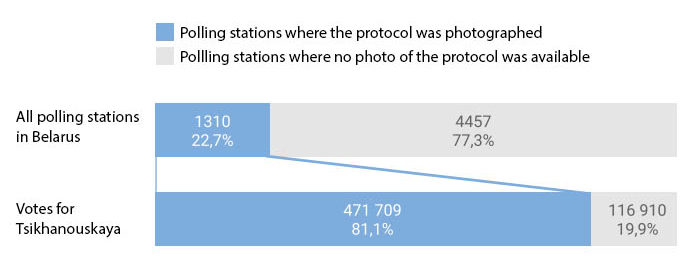
Telling is the example of the capital of Belarus. Golos analyzed the official protocols and found that the votes for Tsikhanouskaya from the official protocols at 432 stations already exceed her total amount of votes in Minsk, if we are to believe the CEC. The situation is similar in the Minsk oblast:
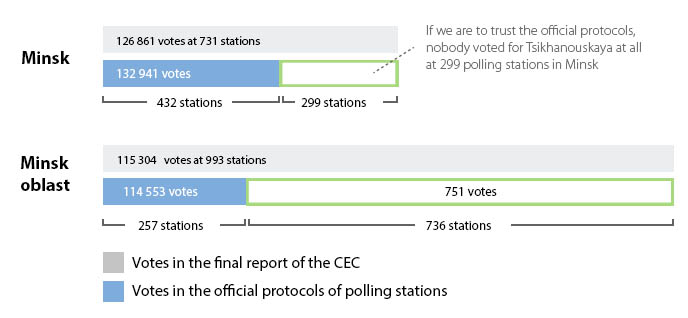
This is statistical proof that the CEC falsified the data to give Tsikhanouskaya a lower result.
[highlight]3. Lukashenka’s high result announced by the CEC is statistically virtually impossible.[/highlight]The share of voters casting their ballot in favor of Lukashenka in those same 1310 protocols is 61.7% – not the 80.1% declared by the CEC – meaning that the CEC falsified the results from the polling stations in favor of Lukashenka.
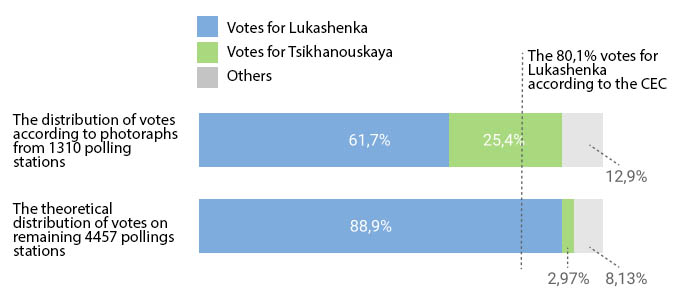
- Furthermore, at the 195 stations where the protocols show Tikhanouskaya won, she received on average 56.7% of the votes, while Lukashenka got 31.3%;
- At the 1115 stations where Lukashenka officially won, he received on average 66.6%, and Tsikhanouskaya – 20.4%;
- that means that at the remaining 4457 stations, Tsikhanouskaya would need to receive 2.97% of the vote while Lukashenka had to score a fantastic 88.85% in order to meet the CEC result of 80.1% nationwide.
The chances of this happening are next to zero, meaning that the official results announced by the CEC data are not to be believed.
Likely, the polling stations were unable to provide the result demanded by the CEC!
[highlight]4. But the protocols shouldn’t be taken at face value – at least 30% were falsified.[/highlight]“It’s important to note that even the 61.7% result isn’t trustworthy given the falsifications taking place at polling stations,” the report by Golos notes.
550 000 voters (9.5% from the total) submitted photos of their ballots. By comparing them and the results of the protocols of polling stations, Golos found that, at the very least, Tsikhanouskaya’s results were falsified at 30% of stations – 400 stations out of 1310!
Regarding the other stations, most of the time there was insufficient data to reach a conclusion – which means falsifications there are possible as well.
3. Searching for the real results with the help of statistical analysis
Methods of statistical analysis are handy for identifying electoral fraud. In Russia, where President Putin and his ruling United Russia party are no strangers to rigged elections, physicist Sergei Shpilkin and other Russian researchers made a habit of deriving how many votes were falsified after each dubious election.
This time, they focused on Belarus as well. While the Belarusian CEC has not made available the final results online, the Golos volunteers digitized the photos of the protocols uploaded to the Zubr platform.
We have used this data to filter out the violations and search for the true results of the vote.
[highlight]Autocrats can’t fool statistics of large datasets – it is impossible to plausibly falsify voting results.[/highlight] The main concept behind the analysis is that normal voting behavior follows a normal distribution, aka a Gaussian curve. Any falsifications will end up being seen as irregularities in the distribution of polling stations with certain characteristics (see example from the Russian Duma election below).
While in Russia, Putin falsifies elections through an abnormally high turnout, in Belarus, they were falsified mostly through early voting.
Observers from the Honest People initiative managed to observe 258 polling stations throughout all the five days of the early voting and declared that the officially declared early voting rate of 41.7% is inflated twofold; the real number is closer to 24%, they declared.
Sergei Spilkin corroborated this estimate – according to him, no more than 20–25% of voters actually voted early.
This is why we cut out the stations where the early voter turnout was over 24% from our analysis:

As seen from the graphs above, the tendency is clear: [highlight]the more early voters at a polling station, the higher Lukashenka’s result in the official protocol for that station.[/highlight]
Note the clusters around the marks of 65% and 85% for Lukashenka and 5% and 15% for Tsikhanouskaya. As Russian researcher Azat Gabdulvaleev illustrates, these clusters are explained by specific localities reporting results in a predetermined way: for instance, in Minsk Lukashenka’s scores were suspiciously consistent for 40 stations, hovering around 63%, while Tsikhanouskaya scored a stable 15%.
A plot of the frequency distribution of early voting and turnout (below) reveals that, compared to a theoretical normal distribution, the share of early voting at 50% appears to be inflated; with the turnout, the number of polling stations where it exceeded 80% differs greatly from the normal distribution and resembles the falsification patterns in Russia.
Therefore, we excluded polling stations where the total turnout exceeded 80% from our analysis.
However, the impact of this artificially inflated high turnout differs from that in Russia.
While in Russia, the inflated turnout is associated with inflated voting in favor of Putin and his party, in Belarus, the relationship was less clear. In the graph below, while a cluster of Tsikhanouskaya’s results at 5% is seen in stations with a turnout above 80%, such suspicious clusters hinting at falsifications (5 and 15% for Tsikhanouskaya, circa 55% for Lukashenka) are more clearly visible at stations where the turnout was officially declared between 60-70%.
Note the turnout above 100% turnout in several polling stations – a hallmark of falsification – and outlier stations where 90% or more were in support for Tsikhanouskaya.
Presumably, these are the several stations where the vote was honest – many videos were shared on Belarusian social media showing how committee members doing an honest vote were applauded when exiting the station:
Some polling stations have done an honest vote count in #BelarusPresidentialElection which shows Tsikhanouskaya's confident victory over incumbent Lukashenka. In some, she scored 4x more votes. Here voters cheer at such a station, chanting "thank you!" https://t.co/uib1AgaJyy pic.twitter.com/VnXHQvF6Sr
— Euromaidan Press (@EuromaidanPress) August 10, 2020
Now, the share of votes for candidates at polling stations should also have a normal distribution (with rare exceptions), if results are not falsified. In the graph below, we compare the observed distribution of votes for Tsikhanouskaya and Lukashenka with the a theoretical (simulated) normal distribution that should have been observed, were there no falsifications.
Anomalous peaks of stations where Tsikhanouskaya scored very little (3%, 8%, 15%), and Lukashenka scored very much (67%, 85%) are clearly visible.
This, also, is statistical proof of a falsified election. It is statistically impossible for Tsikhanouskaya to have such an irregular share of votes that is so skewed towards minimum values if there was no outside interference.

What would the results look like if we are to exclude stations where the early vote exceeded 24% and the turnout exceeded 80%?
In our table below, Lukashenka scored 61.8% based on the protocols from 1285 polling stations digitized by Golos which had complete information (they covered 1 850 637 ballots, which is 31.8% of the total turnout of 5 818 955), while 25.1% of the votes were for Tsikhanouskaya (which is 2.5 times higher than the final results of the election declared by the Central Elections Committee, again pointing at massive falsifications at the highest electoral system level).
More than half of those stations had a turnout over 80%; however, excluding them from the analysis did not impact the results much: 57.8% of the remaining ballots were for Lukashenka.
But excluding stations where the share of early voters was over 24% gave drastic results – Lukashenka’s score dropped to 40.5%, while Tsikhanouskaya’s rose to 47.9%!
Of course, our method of filtering out violations does not account for all of them. It can’t find all the dishonest stations, and can’t filter out minor skewing in favor of Lukashenka, forced voting of state employees, and forced voting at closed stations such as prisons.
But even this primitive analysis indicates that, [highlight]at the very least, a second tour of elections was due![/highlight]

| Official CEC results |
All protocols digitized by Golos |
Where turnout is under 80% |
Where share of early vote is under 25% |
|
| Polling stations |
5767 |
1285 |
559 |
111 |
| Ballots at these stations |
5 818 955 |
1 850 637 |
725 171 |
142 654 |
| % for Lukashenka |
80.1 |
61.8 |
57.8 |
40.5 |
| % for Tsikhanouskaya |
10.1 |
25.1 |
25.9 |
47.9 |
Note: Golos analyzed 1310 stations, we excluded the ones with incomplete protocols, leaving 1285 stations
Our results corroborate those of Novaya Gazeta, which also came to the conclusion that Tsikhanouskaya would have won the first round, if there were no falsifications.
4. First-person accounts of falsifications
First-hand accounts of incidents of falsifications are the cherry on the cake of the general picture of the astonishingly fraudulent elections in Belarus.
There was the audio recording of election commission members rehearsing reading the predetermined “result.”
There was the museum director who was found dead after refusing to sign a false election protocol.
There were the teachers who refused to sign falsified protocols and started sharing details of what went on in the polling stations with media. The boxes for early voting had packs of ballots in favor of Lukashenka which were obviously faked. The final true protocol showing Tsikhanouskaya’s victory was torn up and one testifying to Lukashenka’s victory was drawn up instead.
There was the recording where a Vitebsk city district authority pressured an election commission head to falsify the protocol showing Tsikhanouskaya’s victory in favor of Lukashenka.
There were the half-burned ballots found in a boiler room in Brest:
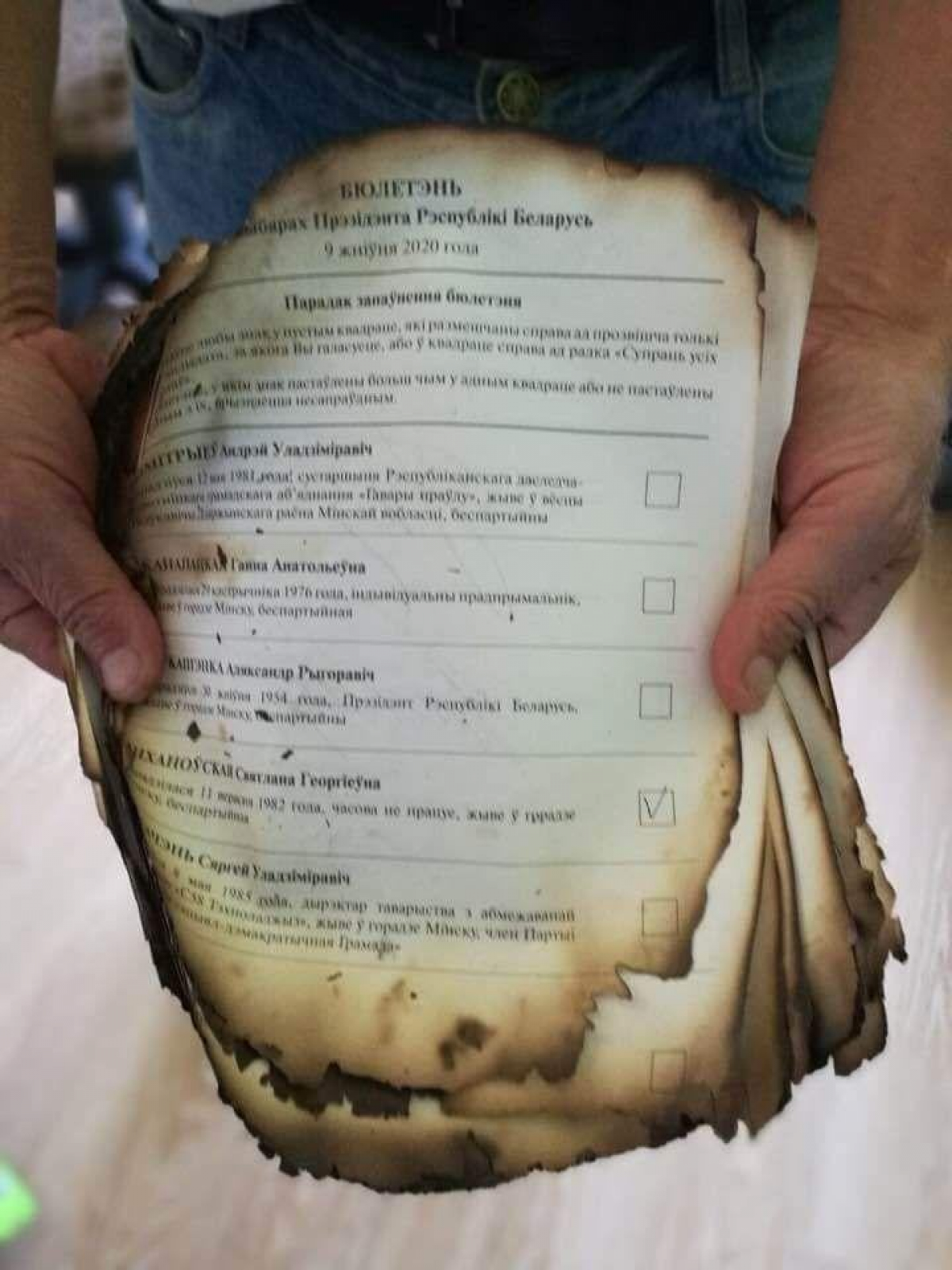
We will never find out the true picture of the vote.
And that, shortly, is why Belarusians are protesting for nearly the second week in a row.
Read also:
- “You all know your numbers”: polling station rehearsed announcement of Belarus dictator Lukashenka’s “victory”
- Belarusian police detain and beat teenagers, injure 5-year-old
- Mother says her son died in hospital after being arrested in Homyel, Belarus
- Wave of strikes sweeps over Belarusian industry on third day of protests against rigged elections
- Ukrainian human rights activists detained in Minsk
- Presidential challenger Tsikhanouskaya leaves country as Belarusian media broadcast strange video
- Support Belarusian pro-democratic activists and their families
- Belarus election: contested result sparks massive unrest as Europe’s ‘last dictator’ claims victory
- From “deescalation and dialogue” to “listening to demands for change”: international reactions to Belarus elections
- Why we will cover the protests in Belarus – Editorial
- 5,000 detained as Belarus protests against rigged elections second day in a row, national strike announced
- What you need to know about the unprecedented Belarus presidential election, in a nutshell


